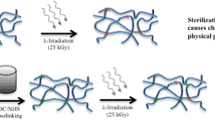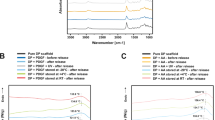Abstract
In vitro characterization of synthetic scaffolds in the laboratory commonly employs sterilization techniques, such as, ultraviolet light or ethanol (EtOH) soaking. These sterilization methods are not sufficient, however, to gain Regulatory approval for therapeutic use. Neglecting the effects medical grade sterilization may have on material properties could lead to years of research never translating to the clinic. The objective of this study was to ascertain whether medical grade gamma irradiation affected the properties of solvent-cast poly(ε-caprolactone)/poly(d, l-lactic acid) blend films for peripheral nerve repair. Scaffolds were sterilized at eight incremental doses of Gamma radiation (0–45 kGy). With increasing radiation dose, tensile testing identified significant reductions in both maximum tensile strength (>40 %) and strain (>90 %); gel permeation chromatography showed a dose-dependent reduction in polymer molecular weight (>46 %) and differential scanning calorimetry highlighted an increase in crystallinity. NG108-15 nerve cells were cultured up to 7 days on gamma irradiated and EtOH soaked films (control). Scanning electron microscopy showed cells proliferated on all films during this time and confirmed cell morphology was unaffected by sterilization method. However, cellular proliferation and number were greater for gamma irradiated films compared to EtOH soaked. Despite material properties being significantly altered, the in vitro response was encouraging and gamma irradiation may prove effective for medical grade sterilization of films intended for peripheral nerve repair.










Similar content being viewed by others
References
Schlosshauer B, Dreesmann L, Schaller HE, Sinis N. Synthetic nerve guide implants in humans: a comprehensive survey. Neurosurgery. 2006;59:740–7. Discussion 7–8.
Grant GA, Goodkin R, Kliot M. Evaluation and surgical management of peripheral nerve problems. Neurosurgery. 1999;44:825–39.
Mackinnon SE. New directions in peripheral nerve surgery. Ann Plast Surg. 1989;22:257–73.
Heath CA, Rutkowski GE. The development of bioartificial nerve grafts for peripheral-nerve regeneration. Trends Biotechnol. 1998;16:163–8.
Meek MF, Coert JH. US Food and Drug Administration/Conformit Europe- approved absorbable nerve conduits for clinical repair of peripheral and cranial nerves. Ann Plast Surg. 2008;60:466–72.
Sun M, Downes S. Physicochemical characterisation of novel ultra-thin biodegradable scaffolds for peripheral nerve repair. J Mater Sci Mater Med. 2009;20:1181–92.
Sun M, Kingham PJ, Reid AJ, Armstrong SJ, Terenghi G, Downes S. In vitro and in vivo testing of novel ultrathin PCL and PCL/PLA blend films as peripheral nerve conduit. J Biomed Mater Res A. 2010;93:1470–81.
Sun M, McGowan M, Kingham PJ, Terenghi G, Downes S. Novel thin-walled nerve conduit with microgrooved surface patterns for enhanced peripheral nerve repair. J Mater Sci Mater Med. 2010;21:2765–74.
Council Directive 93/42/EEC of 14 June 1993 concerning medical devices. In: Legislation OjotEC, editor. L169. Luxembourg: Office for Official Publications of the European Communities; 1993. pp. 1–43.
Rogers WJ. Sterilisation of polymer healthcare products. Shrewsbury: Rapra Technology; 2005.
Gopal NGS. Radiation sterilization of pharmaceuticals and polymers. Radiat Phys Chem. 1978;12:35–50.
Mendes GCC, Brandão TRS, Silva CLM. Ethylene oxide sterilization of medical devices: a review. Am J Infect Control. 2007;35:574–81.
Rutala WA. Disinfection and sterilization of patient-care items. Infect Control Hosp Epidemiol. 1996;17:377–84.
Clough RL. High-energy radiation and polymers: a review of commercial processes and emerging applications. Nucl Instrum Methods Phys Res B. 2001;185:8–33.
Benson RS. Use of radiation in biomaterials science. Nucl Instrum Methods Phys Res B. 2002;191:752–7.
USEPA. Radionuclitides: cobalt. United States Environmental Protection Agency; 2011.
Kurtz SM, Muratoglu OK, Evans M, Edidin AA. Advances in the processing, sterilization, and crosslinking of ultra-high molecular weight polyethylene for total joint arthroplasty. Biomaterials. 1999;20:1659–88.
Kurtz SM, Pruitt LA, Jewett CW, Foulds JR, Edidin AA. Radiation and chemical crosslinking promote strain hardening behavior and molecular alignment in ultra high molecular weight polyethylene during multi-axial loading conditions. Biomaterials. 1999;20:1449–62.
Porte-Durrieu MC, Aymes-Chodur C, Betz N, Baquey C. Development of “heparin-like” polymers using swift heavy ion and gamma radiation. I. Preparation and characterization of the materials. J Biomed Mater Res. 2000;52:119–27.
Kumbar SG, Nair LS, Bhattacharyya S, Laurencin CT. Polymeric nanofibers as novel carriers for the delivery of therapeutic molecules. J Nanosci Nanotechnol. 2006;6:2591–607.
Odelius K, Plikk P, Albertsson AC. The influence of composition of porous copolyester scaffolds on reactions induced by irradiation sterilization. Biomaterials. 2008;29:129–40.
Plikk P, Odelius K, Hakkarainen M, Albertsson AC. Finalizing the properties of porous scaffolds of aliphatic polyesters through radiation sterilization. Biomaterials. 2006;27:5335–47.
Gorna K, Gogolewski S. The effect of gamma radiation on molecular stability and mechanical properties of biodegradable polyurethanes for medical applications. Polym Degrad Stab. 2003;79:465–74.
Crescenzi V, Manzini G, Calzolari G, Borri C. Thermodynamics of fusion of poly-β-propiolactone and poly-ϵ- caprolactone. Comparative analysis of the melting of aliphatic polylactone and polyester chains. Eur Polymer J. 1972;8:449–63.
Ahmed J, Zhang J, Song Z, Varshney S. Thermal properties of polylactides. J Therm Anal Calorim. 2009;95:957–64.
Goldberg M, Langer R, Jia X. Nanostructured materials for applications in drug delivery and tissue engineering. J Biomater Sci Polym Ed. 2007;18:241–68.
Han D, Gouma P-I. Electrospun bioscaffolds that mimic the topology of extracellular matrix Nanomedicine Nanotechnology, Biology and Medicine 2006;2:37-41.
Zhou F, Yuan L, Huang H, Chen H. Phenomenon of “contact guidance” on the surface with nano-micro-groove-like pattern and cell physiological effects. Chin Sci Bull. 2009;54:3200–5.
Cottam E, Hukins DW, Lee K, Hewitt C, Jenkins MJ. Effect of sterilisation by gamma irradiation on the ability of polycaprolactone (PCL) to act as a scaffold material. Med Eng Phys. 2009;31:221–6.
Güven O, Alacakir A, Tan E. An atomic force microscopic study of the surfaces of polyethylene and polycarbonate films irradiated with gamma rays. Radiat Phys Chem. 1997;50:165–70.
Jenkins MJ, Harrison KL, Silva MMCG, Whitaker MJ, Shakesheff KM, Howdle SM. Characterisation of microcellular foams produced from semi-crystalline PCL using supercritical carbon dioxide. Eur Polymer J. 2006;42:3145–51.
Bosworth LA, Gibb A, Downes S. Gamma irradiation of electrospun poly(ε-caprolactone) fibers affects material properties but not cell response. J Polym Sci B. 2012;50:870–6.
Masson V, Maurin F, Fessi H, Devissaguet JP. Influence of sterilization processes on poly(epsilon-caprolactone) nanospheres. Biomaterials. 1997;18:327–35.
Bosworth LA, Downes S. Physicochemical characterisation of degrading polycaprolactone scaffolds. Polym Degrad Stab. 2010;95:2269–76.
Clough R. Radiation-resistant polymers. Encyclopedia of polymer science and engineering. 2nd ed. New York: Wiley-Interscience; 1988. p. 667–708.
Clough RL, Gillen KT. Stabilizer additives in ionizing radiation environments under oxidizing conditions. Polym Degrad Stab. 1990;30:309–17.
Butler DL, Goldstein SA, Guilak F. Functional tissue engineering: the role of biomechanics. J Biomech Eng. 2000;122:570–5.
Birkinshaw C, Buggy M, Henn GG, Jones E. Irradiation of poly–lactide. Polym Degrad Stab. 1992;38:249–53.
Narkis M, Sibony-Chaouat S, Siegmann A, Shkolnik S, Bell JP. Irradiation effects on polycaprolactone. Polymer. 1985;26:50–4.
Borschel GH, Kia KF, Kuzon WM Jr, Dennis RG. Mechanical properties of acellular peripheral nerve. J Surg Res. 2003;114:133–9.
Author information
Authors and Affiliations
Corresponding author
Rights and permissions
About this article
Cite this article
Gibb, A., Mobasseri, S.A., Downes, S. et al. Medical grade sterilization affects synthetic polymer film properties intended for peripheral nerve repair: an in vitro study. J Mater Sci: Mater Med 24, 701–711 (2013). https://doi.org/10.1007/s10856-012-4821-1
Received:
Accepted:
Published:
Issue Date:
DOI: https://doi.org/10.1007/s10856-012-4821-1




